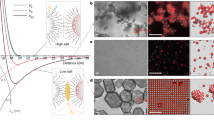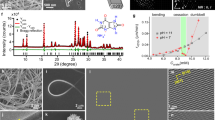Abstract
We describe the use of low-molecular-weight supramolecular gels as media for the growth of molecular crystals. Growth of a range of crystals of organic compounds, including pharmaceuticals, was achieved in bis(urea) gels. Low-molecular-weight supramolecular gelators allow access to an unlimited range of solvent systems, in contrast to conventional aqueous gels such as gelatin and agarose. A detailed study of carbamazepine crystal growth in four different bis(urea) gelators, including a metallogelator, is reported. The crystallization of a range of other drug substances, namely sparfloxacin, piroxicam, theophylline, caffeine, ibuprofen, acetaminophen (paracetamol), sulindac and indomethacin, was also achieved in supramolecular gel media without co-crystal formation. In many cases, crystals can be conveniently recovered from the gels by using supramolecular anion-triggered gel dissolution; however, crystals of substances that themselves bind to anions are dissolved by them. Overall, supramolecular gel-phase crystallization offers an extremely versatile new tool in pharmaceutical polymorph screening.
This is a preview of subscription content, access via your institution
Access options
Subscribe to this journal
Receive 12 print issues and online access
$259.00 per year
only $21.58 per issue
Buy this article
- Purchase on Springer Link
- Instant access to full article PDF
Prices may be subject to local taxes which are calculated during checkout






Similar content being viewed by others
References
Henisch, H. K. Crystal Growth in Gels (Pennsylvania State University Press, 1976).
Petrova, R. I., Patel, R. & Swift, J. A. Habit modification of asparagine monohydrate crystals by growth in hydrogel media. Cryst. Growth Des. 6, 2709–2715 (2006).
Daiguebonne, C. et al. Lanthanide-based molecular materials: gel medium induced polymorphism. Cryst. Growth Des. 3, 1015–1020 (2003).
Desiraju, G. R., Curtin, D. Y. & Paul, I. C. Crystal-growth by non-aqueous gel-diffusion. J. Am. Chem. Soc. 99, 6148 (1977).
Yaghi, O. M., Li, G. M. & Li, H. L. Crystal growth of extended solids by nonaqueous gel diffusion. Chem. Mater. 9, 1074–1076 (1997).
Henisch, H. K. & Garciaruiz, J. M. Crystal-growth in gels and Liesegang ring formation. 2. Crystallization criteria and successive precipitation. J. Cryst. Growth 75, 203–211 (1986).
Petrova, R. I. & Swift, J. A. Selective growth and distribution of crystalline enantiomers in hydrogels. J. Am. Chem. Soc. 126, 1168–1173 (2004).
Li, H., Fujiki, Y., Sada, K. & Estroff, L. A. Gel incorporation inside of organic single crystals grown in agarose hydrogels. CrystEngComm doi:10.1039/c1030ce00118j (2010).
McCauley, J. W. & Roy, R. Controlled nucleation and crystal-growth of various CaCO3 phases by silica-gel technique. Am. Miner. 59, 947–963 (1974).
Terech, P. & Weiss, R. G. Low molecular mass gelators of organic liquids and the properties of their gels. Chem. Rev. 97, 3133–3160 (1997).
George, M. & Weiss, R. G. Molecular organogels. Soft matter comprised of low-molecular-mass organic gelators and organic liquids. Acc. Chem. Res. 39, 489–497 (2006).
Dastidar, P. Supramolecular gelling agents: can they be designed? Chem. Soc. Rev. 37, 2699–2715 (2008).
Piepenbrock, M.-O. M., Lloyd, G. O., Clarke, N. & Steed, J. W. Metal- and anion-binding supramolecular gels. Chem. Rev. 110, 1960–2004 (2010).
Hirst, A. R., Escuder, B., Miravet, J. F. & Smith, D. K. High-tech applications of self-assembling supramolecular nanostructured gel-phase materials: from regenerative medicine to electronic devices. Angew. Chem. Int. Ed. 47, 8002–8018 (2008).
Maeda, H. Anion-responsive supramolecualr gels. Chem. Eur. J. 36, 11274–11282 (2008).
Sangeetha, N. M. & Maitra, U. Supramolecular gels: functions and uses. Chem. Soc. Rev. 34, 821–836 (2005).
Abdallah, D. J. & Weiss, R. G. Organogels and low molecular mass organic gelators. Adv. Mater. 12, 1237–1247 (2000).
Estroff, L. A. & Hamilton, A. D. Effective gelation of water using a series of bis-urea dicarboxylic acids. Angew. Chem. Int. Ed. 39, 3447–3450 (2000).
Estroff, L. A., Addadi, L., Weiner, S. & Hamilton, A. D. An organic hydrogel as a matrix for the growth of calcite crystals. Org. Biomol. Chem. 2, 137–141 (2004).
Hartgerink, J. D., Beniash, E. & Stupp, S. I. Self-assembly and mineralization of peptide-amphiphile nanofibers. Science 294, 1684–1688 (2001).
Lloyd, G. O. & Steed, J. W. Anion-tuning of supramolecular gel properties. Nature Chem. 1, 437–442 (2009).
Stahly, G. P. Diversity in single- and multiple-component crystals. The search for and prevalence of polymorphs and cocrystals. Cryst. Growth Des. 7, 1007–1026 (2007).
Piepenbrock, M. M., Clarke, N. & Steed, J. W. Metal ion and anion based ‘tuning’ of a supramolecular metallogel. Langmuir 25, 8451–8456 (2009).
Piepenbrock, M.-O. M., Lloyd, G. O., Clarke, N. & Steed, J. W. Gelation is crucially dependent on functional group orientation and may be tuned by anion binding. Chem. Commun. 2644–2646 (2008).
Ton, C. Q. & Bolte, M. 2-Hydroxybenzyl alcohol-phenanthroline (1/1). Acta Crystallogr. Sect. E 65, O2936–U2505 (2009).
Vishweshwar, P., McMahon, J. A., Oliveira, M., Peterson, M. L. & Zaworotko, M. J. The predictably elusive form II of aspirin. J. Am. Chem. Soc. 127, 16802–16803 (2005).
Bond, A. D., Boese, R. & Desiraju, G. R. On the polymorphism of aspirin: crystalline aspirin as intergrowths of two ‘polymorphic’ domains. Angew. Chem. Int. Ed. 46, 618–622 (2007).
Grzesiak, A. L., Lang, M. D., Kim, K. & Matzger, A. J. Comparison of the four anhydrous polymorphs of carbamazepine and the crystal structure of form I. J. Pharm. Sci. 92, 2260–2271 (2003).
Lang, M. D., Grzesiak, A. L. & Matzger, A. J. The use of polymer heteronuclei for crystalline polymorph selection. J. Am. Chem. Soc. 124, 14834–14835 (2002).
Florence, A. J. et al. Two-dimensional similarity between forms I and II of cytenamide, a carbamazepine analogue. CrystEngComm 10, 811–813 (2008).
Gelbrich, T. & Hursthouse, M. B. Systematic investigation of the relationships between 25 crystal structures containing the carbamazepine molecule or a close analogue: a case study of the XPac method. CrystEngComm 8, 448–460 (2006).
Harris, R. K. et al. Structural studies of the polymorphs of carbamazepine, its dihydrate and two solvates. Org. Process Res. Dev. 9, 902–910 (2005).
Lang, M. D., Kampf, J. W. & Matzger, A. J. Form IV of carbamazepine. J. Pharm. Sci. 91, 1186–1190 (2002).
Rafilovich, M. et al. Groth's original concomitant polymorphs revisited. Cryst. Growth Des. 5, 2197–2209 (2005).
Fucke, K., Qureshi, N., Yufit, D. S., Howard, J. A. K. & Steed, J. W. Hydrogen bonding is not everything: extensive polymorphism in a system with conserved hydrogen bonded synthons. Cryst. Growth Des. 10, 880–886 (2010).
Pauchet, M., Morelli, T., Coste, S., Malandain, J. J. & Coquerel, G. Crystallization of (+/−)-modafinil in gel: access to form I, form III and twins. Cryst. Growth Des. 6, 1881–1889 (2006).
Davey, R. J., Williams-Seton, L., Lieberman, H. F. & Blagden, N. Stabilizing a solid–solid interface with a molecular-scale adhesive. Nature 402, 797–799 (1999).
Williams-Seton, L., Davey, R. J. & Lieberman, H. F. Solution chemistry and twinning in saccharin crystals: a combined probe for the structure and functionality of the crystal-fluid interface. J. Am. Chem. Soc. 121, 4563–4567 (1999).
Burnett, D. J., Thielmann, F. & Sokoloski, T. D. Investigating carbamazepine-acetone solvate formation via dynamic gravimetric vapor sorption. J. Therm. Anal. Calorim. 89, 693–698 (2007).
Fleischman, S. G. et al. Crystal engineering of the composition of pharmaceutical phases: multiple-component crystalline solids involving carbamazepine. Cryst. Growth Des. 3, 909–919 (2003).
McMahon, L. E., Timmins, P., Williams, A. C. & York, P. Characterization of dihydrates prepared from carbamazepine polymorphs. J. Pharm. Sci. 85, 1064–1069 (1996).
Kerr, K. A., Richardson, J. F. & Eddy, D. D. 3-Hydroxy benzyl alcohol. ACA Abstr. Papers (Winter) 13, 67 – CSD refcode FACCOB (1985).
Capacci-Daniel, C., Gaskell, K. J. & Swift, J. A. Nucleation and growth of metastable polymorphs on siloxane monolayer templates. Cryst. Growth Des. 10, 952–962 (2010).
Hiremath, R., Basile, J. A., Varney, S. W. & Swift, J. A. Controlling molecular crystal polymorphism with self-assembled monolayer templates. J. Am. Chem. Soc. 127, 18321–18327 (2005).
Vrecer, F., Vrbinc, M. & Meden, A. Characterization of piroxicam crystal modifications. Int. J. Pharm. 256, 3–15 (2003).
Li, Y., Wang, T. & Liu, M. Ultrasound induced formation of organogel from a glutamic dendron. Tetrahedron 63, 7468–7473 (2007).
Munoz-Rojas, D., Oro-Sole, J. & Gomez-Romero, P. Spontaneous self-assembly of Cu2O@PPy nanowires and anisotropic crystals. Chem. Commun. 5913–5915 (2009).
Munoz-Rojas, D., Oro-Sole, J. & Gomez-Romero, P. From nanosnakes to nanosheets: a matrix-mediated shape evolution. J. Phys. Chem. C 112, 20312–20318 (2008).
Munoz-Espi, R., Burger, C., Krishnan, C. V. & Chu, B. Polymer-controlled crystallization of molybdenum oxides from peroxomolybdates: structural diversity and application to catalytic epoxidation. Chem. Mater. 20, 7301–7311 (2008).
Acknowledgements
The authors thank the Engineering and Physical Sciences Research Council, GlaxoSmithKline and the Association of the Commonwealth Universities for funding.
Author information
Authors and Affiliations
Contributions
J.A.F., M.-O.M.P. and G.O.L. undertook the synthesis of gelators, experimental studies and rheology measurements. N.C. supervised the rheology work, J.A.K.H. supervised the crystallographic work and J.W.S. was responsible for overall project concept, direction and coordination. All authors contributed to writing the manuscript.
Corresponding author
Ethics declarations
Competing interests
The authors declare no competing financial interests.
Supplementary information
Rights and permissions
About this article
Cite this article
Foster, J., Piepenbrock, MO., Lloyd, G. et al. Anion-switchable supramolecular gels for controlling pharmaceutical crystal growth. Nature Chem 2, 1037–1043 (2010). https://doi.org/10.1038/nchem.859
Received:
Accepted:
Published:
Issue Date:
DOI: https://doi.org/10.1038/nchem.859
This article is cited by
-
Braiding, branching and chiral amplification of nanofibres in supramolecular gels
Nature Chemistry (2019)
-
A Peptide Amphiphile Organogelator of Polar Organic Solvents
Scientific Reports (2017)
-
Halogen-bonding-triggered supramolecular gel formation
Nature Chemistry (2013)
-
Urea derivatives as low-molecular-weight gelators
Journal of Inclusion Phenomena and Macrocyclic Chemistry (2013)
-
Novel smart supramolecular metallo-hydrogel that could selectively recognize and effectively remove Pb2+ in aqueous solution
Science China Chemistry (2012)



